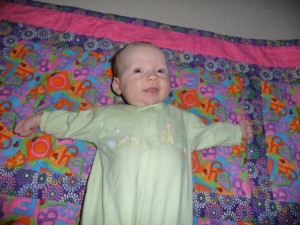Hannah loves to clap. If I am doing yoga, and put my hands in Namaste, she claps. If I am sitting in front of her she grabs my hands to make me clap and sing her new favorite song – Stella Ella Olla. It’s a relief from having to sing the Thong Song (Hannah grooves).
Clapping takes on new significance when you’re watching a baby learn it. It’s a remarkable feat of coordination, I think. And thank goodness her arms are the same length. I wonder, wouldn’t it be harder to clap if they weren’t?
My idle ruminations are someone else’s grant proposal, it would seem. This week in PLoS Biology Lewis Wolpert, an inveterate researcher of pattern formation, discussed the issue of how vertebrate limbs get to be the same length. It’s a more remarkable feat than would seem at first glance. The long bones (think arms and legs) elongate due to the action of growth plates on either end of the bone and how they maintain proper growth rates is a mystery. In fact, at any one time, the rate of growth at these plates can differ by as much as a factor of seven (Wolpert, 2010. PLoS Biology 8:e1000477). All of a sudden, my goofy moment of mom paranoia (oh my God, what if her arms start growing differently?) doesn’t seem so naive.
How living organisms organize their growth is a question that’s been difficult to address until the advent of high throughput genomics and sophisticated computer modeling. This is because there are so many genes involved in pattern development, and each gene can code for a protein that may diffuse, be transported, or degrade quickly. Faced with such complexity, line drawings become meaningless. Instead, molecular biologists are borrowing a page or two from their ecological colleagues and using mathematical models to try to tease apart how these proteins interact. This approach is called systems biology, though it’s essentially ecology applied to molecules.
Mathematical modeling of pattern formation is now sophisticated enough to simulate multiple proteins interacting over any sort of geometrical shape, even a growing shape. The workhorse of this sort of research is the lowly fruitfly, Drosophila melanogaster. The genes responsible for the initiation of pattern formation have been painstakingly investigated by the creation of mutants which are then carefully stained and imaged under the microscope. This work resulted in a Nobel Prize in Medicine for Eric Wieschaus in 1995. It’s an interesting field not only because of all the beautiful microscopy, but also the colorful names of all the genes: Fushi tarazu, sonic hedghog, hunchback, Frankenstein, and Bride of Frankenstein. Because the field of genetics got its start in Drosophila, geneticists had free rein in naming genes for those first heady years. Sadly, there are now rules, and gene naming follows more prosaic guidelines.
Pattern formation in Drosophila is the result of a cascade of proteins that diffuse and initiate the expression of other genes, which in turn diffuse and initiate transcription of others. For example, in Drosophila, as the egg is developing in the female, the anterior end is defined by the deposition of mRNA for a protein called Bicoid. As the mRNA randomly diffuses (actually, is translocated by microtubules) it establishes a gradient. The deposition of mRNA called Nanos at the other end defines the posterior. Once the egg is fertilized, these mRNAs are translated into proteins, and the relative concentration of each protein essentially tell the nuclei where they are along the length of the egg.
All this discussion of fruit fly babies does mean something for human babies. Essentially, pattern formation in all organisms follows similar rules. In fact, these Drosophila genes have homologs in all animals. They are called homeobox genes and are present in all bilateral animals, even some jellyfish. And these same class of genes are also active during limb formation.
Enter systems biology: recently, work in Science Signaling described recent advances in mathematical modeling of limb formation (Mackem and Lewandoski, 2009, Science Signaling, 2:71). The mathematics highlights something quite interesting and unexpected: the intricacy of the gene networks serves not only to make sure that the limb develops as it should, but that it does it despite challenges from mutations, changes in external temperature, or challenges from nutrition. In other words, these complex networks ensure that pattern formation program is robust to a number of challenges. That means that even if Hannah likes fries at her tender age, that one introduction to them will not result in strangely misshapen limbs. Like so much about our biology, there are numerous fail safes. Animals have evolved over millennia, under conditions that can be harsh and unforgiving, and the successful ancestors were the ones who could develop and reproduce despite anything that nature threw at them. So despite the vicissitudes of earthly existence, your ancestors, and Hannah’s ancestors, were the ones who kept clapping.


Trackbacks/Pingbacks
……
Need cheap generic VIAGRA?…